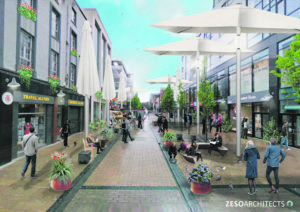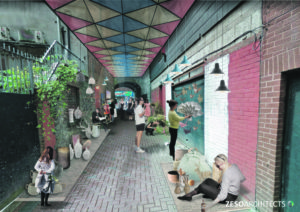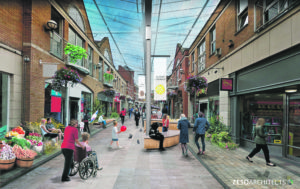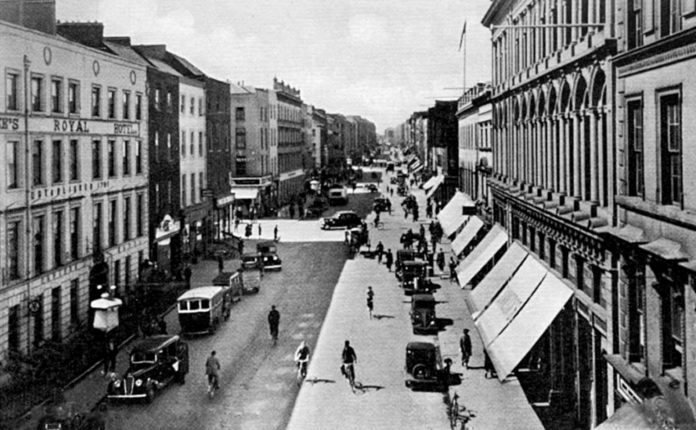
From the concept of a ‘soft day’ to the cinematic soakings in Angela’s Ashes, it seems that Limerick is synonymous with rain. Spitting rain, driving rain, sideways rain, lashing rain – it’s all part of the local lexicon. But what if we were to put a roof over the city? Rian Mac Giobúin, creator and founder of Eireannachtharlear.com examines an idea that may not be as fanciful as it seems.
IN 1999, when Miguel Fernandez Lores presented himself for local elections in Pontevedra, Spain, his proposal was simple – to make the city accessible to everyone, especially to the most vulnerable.
His philosophy was that owning a car didn’t give you the right to occupy the public space. Within a month of his election, he had pedestrianised all 300,000 square metres of the medieval centre. Since then, CO2 emissions are down by 70 per cent and nearly three-quarters of what were car journeys are now made on foot or by bicycle. There hasn’t been a road traffic fatality in almost ten years, and while other towns in the region have been shrinking, central Pontevedra has gained 12,000 new inhabitants and seen its local economy thrive.
Pontevedra isn’t the only city trying to remove cars from its centre. Barcelona has been experimenting with the concept of “super blocks” since 1993 and in 2016 launched a new urban mobility plan which aims to reduce traffic in the city by 21 per cent and free up nearly 60 per cent of the space that is currently being used by cars, turning them into so-called “citizens’ spaces”.
The strategy will see heavy vehicular traffic congestion taken out of the city centre, allowing the streets and public spaces to be used by people. Numerous cities, including London, Boston and New York are experimenting with car-free areas and Copenhagen, long-time darling of people friendly urban spaces, saw more bicycles than cars enter the city centre for the first time in 2016.
The desire to remove cars from the city centre is also a theme which is central to the Limerick 2030 plan.
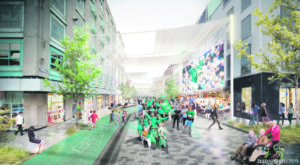
It states that there is a need “to put people before vehicles” and that the city centre transport strategy should seek to remove “as much extraneous car traffic from the city centre as possible”. The plan also seeks “to re-establish the city centre at the top of the shopping hierarchy…….by improving the range and quality of shopping on offer, in the context of a much improved experience of visiting the city centre as a whole”.
It goes on to state that “this ambition can only be achieved by radically improving the shopping experience in the prime shopping area.”
So how can this be achieved?
In terms of the transport strategy, Limerick City and County Council has unveiled plans that will see €9 million spent on redeveloping the city centre. The LUCROC (Limerick Urban Centre Revitalisation of O’Connell Street) project aims to “improve the public realm, regenerate the urban fabric, reduce air pollution, and promote noise reduction”.
While any attempt to improve the city centre is welcomed, many argue that the plans do not go far enough.
#LiveableLimerick, a social movement led by former Secretary General at the Department of Finance John Moran, maintains that the plans submitted to date lack ambition, vision and sustainability and are a poor use of public finances.
The group has proposed the introduction of a “super-block” concept to the city centre and has as its vision an area that gives priority to pedestrians, radically increases the number of green spaces and focuses on communities living, working, visiting and shopping in the city centre.
To improve the range and quality of the shopping on offer, Limerick 2030 proposes a complete refurbishment of Cruises Street through a combination of renovation and redevelopment, allowing a wider range of retail outlets.
The strategy includes a new square/plaza in the area around Arthur’s Quay and Cruises Street which would be ringed by shops, restaurants and cafés. It also proposes that the units on Cruises Street be reconfigured to create larger ground floor units as well as a complete renovation of the facades.
The aim is to remove cars from the city centre where possible, increase footfall and improve the city centre’s retail offering. This makes sense given that both the Limerick City Development Plan 2010-2016 and Limerick 2030 identified the shopping malls located on the outskirts of the city as a key threat to the rejuvenation of the city centre.
Shopping malls are attractive to shoppers as they offer free parking, often tend to be more accessible than city centres, and contain a range of leisure facilities to keep consumers there longer, including cafes, bowling alleys and cinemas.
Perhaps most importantly however, indoor shopping malls are not affected by bad weather.
Limerick city is one of the most westerly cities in Europe and many parts of the West of Ireland can receive up to 225 days of rain a year. While pedestrianisation of the city centre should be welcomed, Irish cities need to be developed in a way that addresses the realities of the Irish climate.
One way that can done is by covering some streets to provide shelter for shoppers.
Covered walkways and thoroughfares could be designed to link the city’s parking, rail stations, bicycle stations and bus stops with the city’s main shopping districts and public buildings.
Limerick wouldn’t be the first city to cover its streets.
Milan has the stunning Galleria Vittorio Emanuele II, while Madrid, Malaga, Seville and Nicosia have all covered streets to protect from the sun. In Bologna, it’s possible to walk in the shade of colonnades and in Toronto a new waterfront development will use real time weather data to determine how to optimize indoor and outdoor spaces.
Japan has introduced covered streets and footpaths in a number of its cities including Kyoto, Osaka and Atami, while in London the Borough, Leandenhall and Covent Garden markets have all been covered, as has Burlington Arcade off Piccadilly.
In fact, Limerick already has a precedent for this.
In 2010 the redeveloped Milk Market was opened as an all-weather, all year round market space. It has been a massive success and a fantastic addition to the city and should be used as an example for what can be done in other parts of the city.
Limerick could start with key pedestrian arteries through the city, possibly trialling smaller streets to start with so as to gauge public opinion and to manage costs. Retractable canopies could be used which could be opened back during the summer or dry days.
Some streets could be fully covered, some only partially. They could be covered with artistic installations similar to what has been done in Agueda in Portugal, others with iconic architectural designs. The Limerick School of Art and Design and the public could be involved in designing and voting on designs, thereby engaging those who live in the city.
#LiveableLimerick was right to call out the city’s original plans as lacking vision. While Limerick City and County Council should be applauded for making real efforts to rejuvenate the city centre, it’s time for Limerick to really step up.
Covering our streets would make the city a nicer, more attractive place for people to spend time, provide a practical solution to the weather and really put Limerick on the map.
So, what would it look like?
Eireannachtharlear.com has been collaborating with Copenhagen-based Zeso Architects, to produce a number of alternative visions for Limerick city centre. The hope is that these will act as inspiration to the decision makers in City Hall and start a conversation about how to really put Limerick on the map.
O’Connell Street is the main artery of the city and, whichever plan is eventually decided upon, it is vital that Limerick City and County Council get it right. LUCROC and #LiveableLimerick have both put forward proposals and each of them is compatible with covered streets or covered sidewalks. A really simple, practical and sleek design would be to utilise the already existing wide pavements and install awnings on either side of the street. Awnings have been used on O’Connell Street for over a hundred years and would provide shelter to passers-by and a stunning visual impact for Limerick’s main boulevard.
One idea for Bedford Row could be a series of umbrella type structures that would provide shelter to residents, shoppers, tourists and those working in the city on a day to day basis. The structures would provide pedestrian respite and opportunities for rest and reflection and the space could be used to host street markets, community events such as #LiveableLimerick’s street fest or even just a space to sit under while you eat your lunch, read a book or chat with some friends.
The smaller streets and lanes around Limerick (for example Little William Street, Todd’s Bow, Fox’s Bow and Little Catherine Street) are where we could really get creative. Any number of materials (stained glass, wood, metal, tensile, etc.) or concepts (wooden beams, umbrellas, doors, chairs, hurleys, rugby balls, whatever) could be used. Design ideas could be submitted by the public on the smaller streets and votes cast to find the public’s favourite design. Artistic installations would act as a tourist attraction in and of themselves and really put Limerick on the map as a destination to visit.
Cruises Street could be covered in its entirety. This would achieve Limerick 2030’s aim of rejuvenating a section of the city which it has identified as the prime shopping area. It would also fit in beautifully with the new Opera Centre development, dramatically improve the shopping experience, and perhaps most importantly provide Limerick with a truly unique selling point. Covering Cruises Street would create a fabulous atmosphere on the street and allow restaurants and cafes to open out onto the street. Not only would the city have a new shopping centre-type experience that could compete with the malls on the outskirts of the city, Cruises Street under cover could offer an alfresco dining experience the envy of every city in Ireland.




